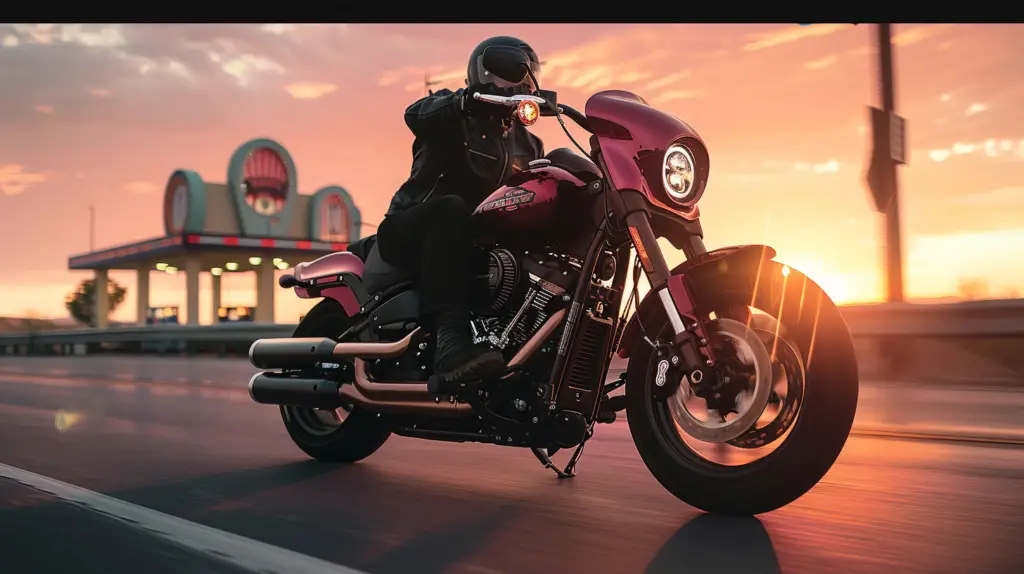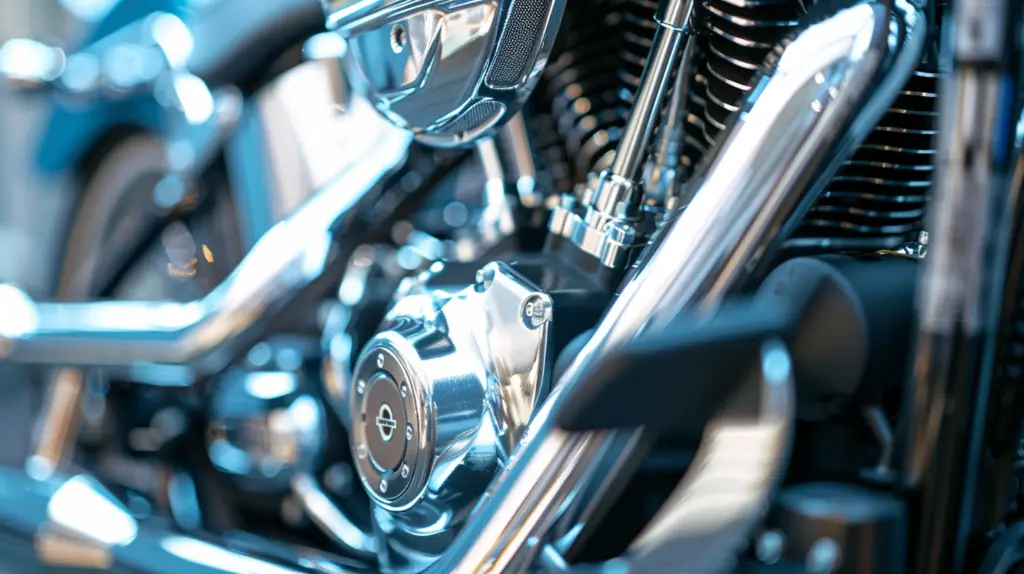If you’re riding a Sport Glide, watch out for common issues like broken mustache engine guard pegs and loose drive belts. Regular checks every 5,000 miles help catch potential problems, including faulty fuel pumps and engine overheating. Make sure your belt tension is correct to avoid slippage and costly repairs. Keep an eye on brake pad wear and brake fluid levels to guarantee safe rides. Proper tire pressure and maintenance habits can improve fuel efficiency. Staying proactive with these tips not only guarantees a smooth ride but also boosts your bike’s resale value. Want more insights to keep your Sport Glide in top shape?
Related read: Round ‘Em Up: What Year Harleys To Avoid? (Full Overview)
Key Takeaways
- Mustache engine guard pegs often break, disrupting rides.
- Loose drive belts can cause slippage and efficiency issues.
- Faulty fuel pumps can lead to significant engine problems.
- Regular tire and brake maintenance is crucial for safety.
- Routine maintenance every 5,000 miles prevents major issues.

Mechanical Problems
When dealing with the Sport Glide, mechanical problems like the mustache engine guard pegs breaking can be particularly frustrating. Imagine you’re out on an open road, enjoying the freedom of the ride, only to find out those pegs are giving way. Not only does this potentially damage your bike, but it can also disrupt that sense of liberation you crave.
Mechanical problems don’t stop there. Front tire replacements and brake repairs are essential for maintaining your bike’s performance and safety. Remember, front brakes provide 70% of your stopping power, so keeping them in top condition is vital. And we both know, nothing kills the thrill of the ride like poor braking.
Regular maintenance is your best ally against these mechanical issues. Routine check-ups every 5,000 miles or six months can prevent small problems from turning into bigger headaches.
When issues do arise, like loose drive belts or faulty fuel pumps, Harley-Davidson Baltimore is your go-to for quick repairs and replacements.
Don’t let these mechanical issues hold you back. Stay proactive with maintenance, and address problems quickly. Your quest for freedom on the open road deserves nothing less.
Drive Belt Tension Related

Drive belt tension issues are a common problem with the Sport Glide, often leading to belt slippage and reduced power transfer. Regular checks and adjustments are essential, and thankfully, these issues are typically covered under dealer warranty services.
Always consult your manual or a certified Harley-Davidson technician to guarantee your drive belt maintains proper tension for best performance.
Common Drive Belt Issues
Maintaining your Sport Glide’s drive belt tension at the proper level is crucial for optimal performance and longevity. Incorrect tension can result in slippage, premature wear, and decreased power transfer, which may prevent you from fully enjoying the freedom of the open road. To keep your ride smooth and powerful, it’s important to regularly inspect and adjust the drive belt tension.
A loose belt can cause slippage, reducing your bike’s efficiency and potentially leading to expensive repairs. Conversely, an excessively tight belt can put unnecessary stress on the belt and other components, leading to premature wear. By keeping the right tension, you ensure seamless operation and prevent drivetrain issues, allowing you to ride with confidence.
Refer to your Sport Glide’s owner’s manual for specific instructions on how to adjust the belt tension. Routine maintenance checks can help you avoid unexpected breakdowns and prolong the lifespan of your bike. Taking a proactive approach to your bike’s upkeep relieves you from concerns about mechanical failures, enabling you to focus on the excitement of the ride.
Dealer Warranty Services
Utilizing dealer warranty services for drive belt tension can help guarantee that your Sport Glide runs smoothly and reliably. Drive belt tension must be checked regularly to ensure peak performance and longevity. Improper tension can lead to issues like reduced power transfer and accelerated wear. Let your dealer handle these adjustments.
Here’s why you should trust dealer warranty services for drive belt tension:
- Expert Technicians: Dealer technicians are trained to adjust drive belt tension according to Harley-Davidson’s precise specifications.
- Quality Assurance: Warranty services ensure that only genuine parts and approved methods are used.
- Cost Savings: Since it’s covered under warranty, you won’t have to shell out extra for these essential adjustments.
- Peace of Mind: Knowing that your bike is in expert hands allows you to ride with confidence.
Fuel Economy Concerns
Although the Sport Glide boasts an average fuel economy of around 47 miles per gallon, real-world efficiency often depends on your riding habits and maintenance routines. If you’re looking to maximize your freedom on the open road, there are a few key things you should keep in mind.
First, maintaining proper tire pressure is important. Under-inflated tires can lead to increased fuel consumption, so make sure to check them regularly.
Regular maintenance is also essential. Keeping your engine in top shape ensures it runs efficiently, translating to better fuel economy.
Don’t forget the importance of smooth riding. Avoiding rapid acceleration and maintaining a steady speed can help you squeeze every mile out of each gallon.
On a full tank, you can expect a range of approximately 200 miles. That’s perfect for those long, liberating rides where the journey is the destination.
Monitor your fuel consumption and refuel regularly. This not only helps maintain peak performance but also keeps you from getting stranded in those remote, freedom-filled landscapes you love exploring.
Engine Overheating

While maximizing fuel efficiency is important, keeping your engine cool is equally vital to guarantee your Sport Glide runs smoothly. Engine overheating is a common issue you could face due to the compact design and limited airflow. Ignoring it can lead to serious engine damage and a noticeable drop in performance.
To avoid these problems, keep an eye out for these signs:
- High temperature readings: Regularly check your temperature gauge. If it consistently shows high readings, your engine might be overheating.
- Steam from the engine: Steam is a clear indicator something’s wrong. If you see steam, pull over immediately to prevent further damage.
- Coolant levels: Low coolant levels can cause overheating. Make it a habit to check and maintain proper coolant levels.
- Regular maintenance: Follow your Sport Glide’s maintenance schedule religiously. This includes checking coolant levels, oil changes, and ensuring your cooling system is functioning properly.
If you do encounter overheating issues, don’t delay—get in touch with a professional mechanic or your dealership for a thorough diagnosis and repair. Ensuring your engine stays cool won’t only prolong its life but also keep your rides smooth and enjoyable.
Fairing Vibrations
Fairing vibrations on your Sport Glide can be a real nuisance, often caused by loose bolts and brackets. These vibrations don’t just annoy; they can lead to further damage if left unchecked. It’s vital to tackle this issue head-on to keep your ride smooth and enjoyable.
You might notice that vibrations increase with engine speed or road conditions. Don’t ignore these signs. Regularly inspect your fairing, ensuring all bolts and brackets are tight. If you’re not comfortable doing this yourself, get professional help. A loose fairing can compromise your bike’s stability, so it’s not something to overlook.
Proper maintenance is important. Schedule regular inspections to catch potential issues early. Addressing fairing vibrations promptly not only improves your riding experience but also prevents more expensive repairs down the line.
Front Tire Issues
Front tire issues on your Sport Glide can greatly affect both safety and performance. You need to keep an eye on tire wear and address any problems immediately. Here are four key points to keep in mind:
Tire Wear and Replacement:
The front tire takes a lot of punishment, and regular inspection is vital. When you notice significant wear, replace the tire promptly to maintain peak grip and handling.
Post-Replacement Caution:
After replacing the front tire, ride cautiously for the first 25 miles. This break-in period ensures the tire settles properly and offers the best functionality.
Impact of Weather:
Weather conditions can have a notable effect on your front tire’s grip. Rain, snow, or even extreme heat can diminish traction, so adjust your riding style accordingly to stay safe.
Maintenance:
Regularly check the front tire for any signs of damage or wear. Proper air pressure, balanced tire alignment, and timely replacements are essential for maintaining the bike’s stability and stopping power.
Important read: The Complete Harley Davidson Tire Pressure Chart You Need
Brake System Maintenance Recommendations
You’ll want to regularly inspect your Sport Glide’s brakes to make sure they’re in top shape. Check the ABS functionality and replace brake pads as needed to maintain peak performance and safety.
Proper brake system maintenance can prevent issues and help you enjoy a smoother ride.
Regular Brake Inspections
Regular brake inspections are vital for guaranteeing your Sport Glide’s safety and peak performance. You can’t afford to overlook this essential aspect of maintenance if you want to ride freely and confidently.
Here’s what you need to focus on:
- Brake Pads: Regularly check your brake pads for wear. Worn-out pads not only reduce braking efficiency but also risk damaging the rotors.
- Rotors: Inspect the rotors for grooves or warping. Smooth, even rotors ensure your brakes perform consistently under various conditions.
- Calipers: Make sure the calipers are functioning correctly and not leaking. Faulty calipers can lead to uneven braking and potential safety hazards.
- Brake Fluid: Monitor the brake fluid level and quality. Low or contaminated brake fluid can compromise braking performance.
ABS Functionality Checks
To maintain your Sport Glide’s safety and control, checking the ABS functionality is essential for ensuring the brake system works correctly during emergency situations. Regular ABS tests, as per the manufacturer’s recommendations, will help you stay safe on the road. The ABS system prevents wheel lock-up by monitoring wheel speed and adjusting braking pressure, an important feature when you need to stop quickly.
Here’s a quick guide to understanding what happens during an ABS check:
| ABS Component | Function |
|---|---|
| ABS Sensors | Monitor wheel speed |
| ABS Module | Processes sensor data and adjusts brake pressure |
| Brake Calipers | Apply the braking force |
| Brake Fluid | Transfers pressure to the calipers |
| Warning Light | Indicates ABS system status |
Brake Pad Replacement
When you notice squeaking, grinding, or reduced braking efficiency, it’s time to replace your Sport Glide’s brake pads to guarantee safe and effective braking. Regular brake pad replacement maintains your bike’s performance and your safety on the road.
Here’s what you need to know about maintaining your Sport Glide’s brakes:
- Inspection Frequency: Regularly inspect your brake pads. Every 5,000 miles or six months, whichever comes first, is a good interval. This helps catch wear and tear early.
- Replacement Timing: Brake pads should be replaced every 20,000 miles or sooner if you notice any signs of wear, such as noise or decreased braking power. Don’t wait until it’s too late.
- Preventative Maintenance: Replacing brake pads on time prevents damage to other components like the brake rotors. This saves you from costly repairs down the road.
- Proper Installation: Ensure new brake pads are installed correctly. Incorrect installation can compromise braking performance and safety.
Fuel Pump Faults to Be Aware Of
Fuel pump faults in the Sport Glide can lead to frustrating issues like difficulty starting, engine sputtering, or sudden stalling. When your fuel pump acts up, it disrupts fuel flow, affecting your bike’s performance and reliability. You deserve a ride that’s smooth and worry-free, so addressing these problems promptly is essential.
Here’s what you might experience:
| Symptom | Possible Cause |
|---|---|
| Difficulty Starting | Weak fuel pump |
| Engine Sputtering | Inconsistent fuel delivery |
| Sudden Stalling | Fuel pump failure |
| Poor Performance | Insufficient fuel pressure |
Imagine hitting the open road, only to face an engine that sputters or stalls unexpectedly. It’s not just annoying—it can be dangerous. Early detection of fuel pump issues can save you from potential breakdowns and costly repairs. Regular maintenance checks can help you catch these problems before they escalate.
Don’t let a faulty fuel pump hold you back. By staying vigilant and addressing issues as they arise, you can keep your Sport Glide running smoothly and enjoy the freedom of the ride without interruptions. Your bike should be a source of liberation, not stress.
Regular Service Intervals to Adhere To
You should stick to Harley-Davidson’s recommendation of servicing your Sport Glide every 5,000 miles. This regular maintenance includes important tasks like oil changes, brake inspections, and tire pressure checks.
Recommended Service Frequency
How often should you service your Sport Glide to guarantee peak performance and reliability? Generally, you should stick to a regular service schedule to keep your ride in top shape. Harley-Davidson recommends servicing your Sport Glide every 5,000 to 10,000 miles, depending on your riding habits and conditions. Following these intervals is important for maintaining performance, safety, and longevity.
Here’s a straightforward guide to help you stay on track:
- 5,000 miles or six months: Perform basic checks like oil changes, tire inspections, and brake fluid top-ups. This ensures your bike runs smoothly and prevents minor issues from becoming major problems.
- 10,000 miles: This more thorough service should include a detailed inspection of the drive belt, brake pads, and other critical components. Catching wear and tear early can save you from costly repairs.
- Every ride: Before you hit the road, do a quick walk-around check. Look for any visible issues and make sure all lights and signals are functioning properly.
- Annual check-up: Even if you haven’t hit the mileage milestones, an annual service will keep your Sport Glide in excellent condition.
Common Maintenance Tasks
Keeping your Sport Glide in top shape involves tackling regular maintenance tasks at specified service intervals. Start with oil changes every 5,000 miles to keep that Milwaukee-Eight engine running smoothly.
Don’t forget to swap out the brake fluid every two years to guarantee your braking system remains responsive and safe.
Your air filter needs replacing every 10,000 miles. It’s a simple task that can prevent a lot of engine issues down the road. Spark plugs should be checked at 20,000 miles and replaced if necessary to maintain peak performance.
Tire pressure and tread depth are critical. Check them regularly to ensure safe handling and grip on the road.
Another key task is monitoring your chain tension and lubrication every 500 miles; it’s essential for smooth operation and longevity.
Don’t overlook regular inspections of suspension components, lights, and controls. Catching issues early can save you from bigger problems and costly repairs.
By staying on top of these maintenance tasks, you’re not just preserving your bike’s reliability—you’re also ensuring every ride feels as free and exhilarating as the first.
Moving forward, you can embrace the open road with confidence, knowing your Sport Glide is in prime condition.




Leave a Reply
You must be logged in to post a comment.